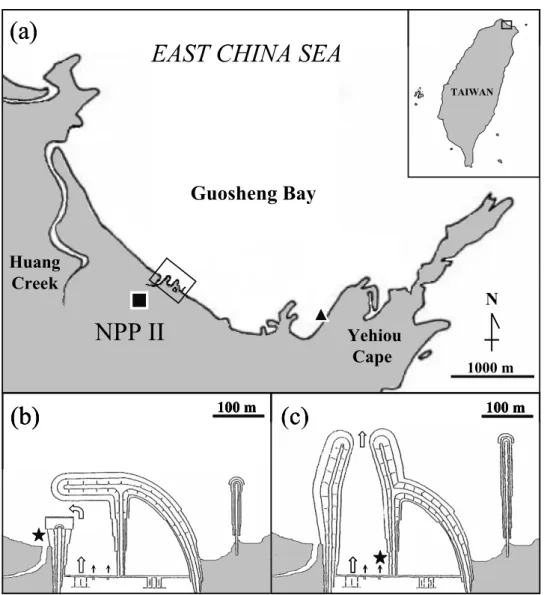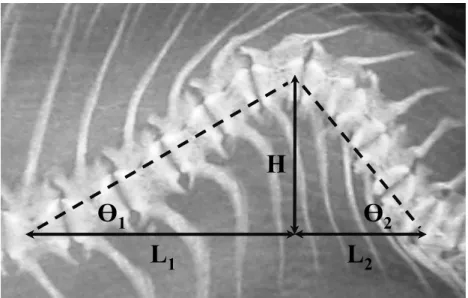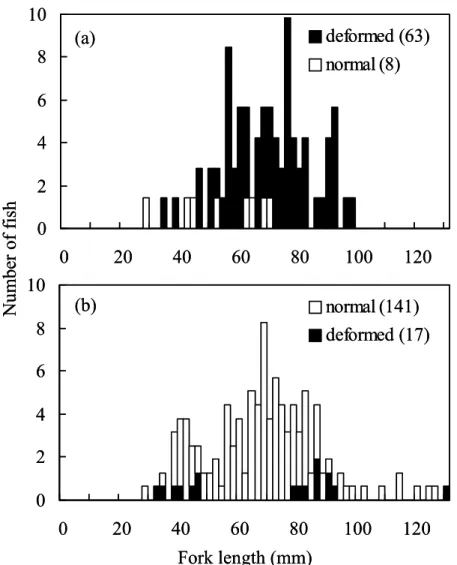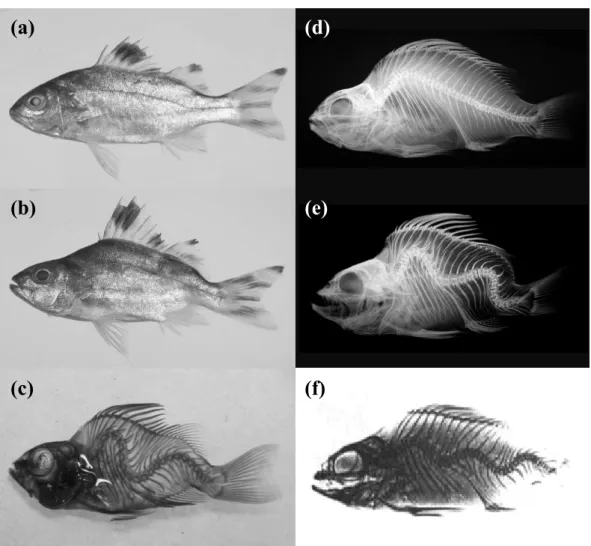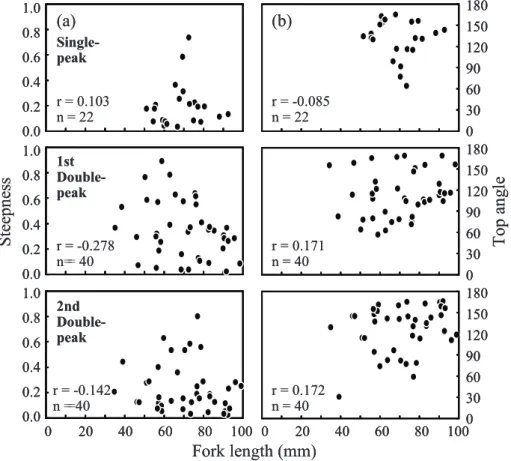1 Vertebral Deformity of the Thornfish in the Thermal Effluent Outlet
INTRODUCTION
Anthropogenic activities and/or construc- tions have been responsible for both indirect (through habitat degradation, alteration and introduction of toxic materials) and direct (through harvest or introduction of exotic species) impacts on coastal fish (Day et al., 1989). Nuclear power plants with a large demand for cooling water to remove the heat associated with power generation are usually located near coasts. In addition to the indirect impacts from local topographic and hydrological changes on fish communities, seawater intake causes direct impingement and loss of fish and the high temperature effluent may interfere with
the physiological processes and behavioral changes of fish (Langford, 1990; Jones et al., 1996; Jan et al., 2001; Chen et al., 2004; Liao et al., 2004). Public concerns about the ecological impact of thermal discharge were strengthened by the routine discovery of conspicuously deformed thornfish Terapon jarbua (Forsskål) in the thermal effluent outlet of the second nuclear power plant (NPP II) in northern Taiwan every summer since 1993 (Anon., 1995; Hung et al., 1998).
Unlike the common spinal malformations in cultured fishes (Afonso et al., 2000; Silverstone and Hammell, 2002; Fraser et al., 2004; Kolstad et al., 2006), massive occurrences of deformed fishes in nature are rarely seen. The thornfish is distributed 1 National Museum of Marine Biology and Aquarium, Checheng, Pingtung 944, Taiwan, ROC
2 Institute of Marine Biodiversity and Evolutionary Biology, National Dong Hwa University, Checheng, Pingtung 944, Taiwan, ROC
3 Fisheries Research Institute, Council of Agriculture, Executive Yuan, Keelung 202, Taiwan, ROC 4 Department of Life Science, College of Life Science, National Taiwan University, Taipei 106, Taiwan, ROC 5 Institute of Fisheries Science, College of Life Science, National Taiwan University, Taipei 106, Taiwan, ROC * Corresponding author, E-mail: wnt@ntu.edu.tw
J. Fish. Soc. Taiwan, 37(1): 1-11
Morphological Study on Vertebral Deformity of the Thornfish
Terapon jarbua in the Thermal Effluent Outlet of a Nuclear
Power Plant in Taiwan
Chih-Wei Chang1,2, Yu-Tzu Wang3 and Wann-Nian Tzeng4,5*
(Received, 0, 2010; Accepted, 0, 2010) ABSTRACT
Massive occurrences of vertebral deformities of fish are not commonly found in the natural environment. However, a great number of deformed thornfish, Terapon jarbua, have been routinely found every summer since 1993 in the thermal effluent outlet of the second nuclear power plant (NPP II) in northern Taiwan. The quantitative prevalence and patterns in deformity of thornfish angled in the outlet water were roentgenogram and bone double-staining examined. The prevalence of malformation decreased dramatically from 88.7% to 10.8% after outlet reconstruction in 1994. Spinal curvature of the fish could be classified into three lordosis types (single-, double- and triple-peak), accounting for 34.9%, 63.5% and 1.6%, respectively, of total deformed individuals. Severities of the spinal curvatures were not correlated with fish length, indicating that the deformity may occur at any fish length in the outlet water.
widely in saline environments varying from marine to freshwater in the Indo-Pacific region (Pauly and Martosubroto, 1996). In Taiwan, it inhabits areas of reef, sandy bottom and estuary, accounting for relatively high commercial value in the coastal long-line fishery and marine aquaculture (Liu, 1978). Larval and juvenile thornfish are abundant in the estuary for nursery and feeding in May to November. The fish matured at ca 140-150 mm fork length and fully grown adults of lengths exceeding 250 mm might retreat to deeper waters off the river mouth for spawning (Miu et al., 1990; Wei, 1995). Given the close connection between fish life pattern and coastal habitats, the presence of massive deformed thornfish in association with the thermal effluent of nuclear power plant inspired our attempt to determine quantitatively the prevalence and pattern of their deformity, which phenomenon had never been observed for the natural thornfish populations elsewhere of the world.
MATERIALS AND METHODS Study site
The NPP II is located on the coastline of Kuosheng Bay in northern Taiwan (Fig. 1a). The shoreline substrate consists of fringe reefs and then sandy bottom ca 100-200 m seaward. Water temperatures range between 17°C in the winter and 27°C in the summer. The thermal effluent channel of the NPP II has drained the discharge northward since initial operation in 1984 (Fig. 1b), which effluent was hindered by the tidal current and conducted the persistent elevated water temperatures of 38-40°C in the summer within and adjacent to the outlet (Anon., 1995). In order to meet the Environmental Protection Administration (EPA) regulation that required that the water temperature at the 500 m radius from the outlet should not exceed 4°C over the background temperature, the channel was reconstructed and the effluent has drained northeastwardly since April 1994. The reconstructed effluent channel was a reverse-funnel shape about 18 m wide and 160 m long at the lateral
drainage embankment. The topography inside the channel consisted of a rocky bottom in the west and concrete plate in the east with respective depths of 3-4 m and 0.3-0.5 m. In addition to the main thermal seawater effluent, two additional reverse-washed freshwater effluents with very little volume also drain into the channel. Westward of the channel is a sandy beach with a shallow domestic freshwater creek (Fig. 1c). Water temperatures at the 500 m radius from the reconstructed outlet were coincided with the EPA regulation although those inside the outlet fluctuated seasonally and were still seldom lower than 28°C in winter and exceeded 37-40°C in summer. However, the thermal effluent was exchanged much easily by the tidal current and did not be persisted adjacent to the outlet (Shao and Lee, 2001).
Deformity analysis
The prevalence of deformed fish, i.e. the percentage of deformed to all individuals, in relation to outlet reconstruction of the NPP II was traced by angling thornfish wherever possible within and adjacent to the outlet construction in August 1993 (before reconstruction) and April to October 1994 (after reconstruction). Fork length of the fish was measured. Significant differences in lengths between deformed and normal individuals of before and after outlet reconstruction were determined by the two-way analysis of variance, whereas those among deformity types of August 1993 were by t-test.
Vertebral deformity of the thornfish collected in August 1993 was further examined by roentgenogram (CMB-2, SOFTEX) and/ or the double-stained bone method (Potthoff, 1984). The number of curvature peaks determined the categories of spinal curvature for the deformed fish. The variations in curvature height, length and angle were evaluated by two parameters, namely steepness and top angle (Fig. 2), which were calculated by the following equations.
3 Vertebral Deformity of the Thornfish in the Thermal Effluent Outlet
Top angle = 180 - (θ1 + θ2) ….….…...(2)
where H was the curvature height, L was the total curvature length of L1 and L2, θ1 and θ2
was arctangent H/L1 and H/L2, respectively.
The two deformity parameters of different curvature peaks were respectively correlated with fish length to elucidate the relationship between severity of vertebral deformity and fish size.
RESULTS
Locations of the thornfish where the deformed individuals appeared were different between sampling years. Before the outlet reconstruction in August 1993, the deformed fish were captured in the waters mixed by the main thermal effluent and the runoff of the adjacent creek (Fig. 1b), whereas those of after reconstruction from April to October
(a)
Guosheng Bay
NPP II
Yehiou
Cape
Huang
Creek
EAST CHINA SEA
N
1000 m TAIWAN(b)
100 m(c)
100 m(a)
Guosheng Bay
NPP II
Yehiou
Cape
Huang
Creek
EAST CHINA SEA
N
1000 m
TAIWAN
(b)
100 m(b)
100 m(c)
(c)
100 m100 mFig. 1. Sampling sites (solid star) for the thornfish before (b) and after (c) reconstruction of the thermal effluent outlet of the second nuclear power plant (NPP II) (a). Solid triangle: seawater intake site; open arrow: thermal effluent; solid arrow: reverse-washed freshwater effluents.
1994 were from the area of the reverse-washed freshwater effluent (Fig. 1c).
A total of 71 thornfish juveniles were collected in 1993 and 158 fish were collected from 1994 in the thermal effluent outlet of the NPP II. Sixty-three deformed individuals constituting 88.7% of total catch were identified in 1993 and 17 deformed individuals (10.8%) were recorded in 1994 (Table 1). The prevalence of malformation of the thornfish decreased dramatically following reconstruction of the effluent outlet in April 1994.
Lengths of the fish between deformed and normal individuals of before and after
outlet reconstruction were not significantly different (p > 0.05). The deformed fish collected in 1993 were very similar in size distribution to the un-deformed normal fish in 1994, with mean ± SD lengths of 68.9 ± 14.6 mm in 1993 and 66.8 ± 18.3 mm in 1994 (Fig. 3). The lengths of deformed fish in 1994, with three distinct size cohorts, were within the length range (28-126 mm) of normal fish in 1994 (Fig. 3b). The broad range of deformed fish sizes indicated that the malformation was not lethal for the thornfish.
The external morphology of the normal thornfish was compressed and spindle in Fig. 2. Schematic diagram of measurements for the evaluation of vertebral deformity.
H
L
1
L
2
Ԧ
1
Ԧ
2
H
L
1
L
2
Ԧ
1
Ԧ
2
Table 1. Sampling size, percentage and fork length of the thornfish collected in the thermal effluent outlet of the second unclear power plant in northern Taiwan
Sample % Fork length (mm)
size Range Mean ± SD
Before outlet reconstruction (August 1993)
Normal form 8 11.3 27.0-69.0 52.8 ± 14.8
Deformed 63 88.7 33.0-97.0 68.9 ± 14.6
Single-peak 22 34.9 49.0-91.0 67.5 ± 10.9
Double-peak 40 63.5 33.0-97.0 69.5 ± 16.6
Triple-peak 1 1.6 75.3 75.3
After outlet reconstruction (April~October 1994)
Normal form 141 89.2 27.0-125.0 66.8 ± 18.3
5 Vertebral Deformity of the Thornfish in the Thermal Effluent Outlet
body form with the posterior of the head slightly distant from the origin of first dorsal fin and a head length ca 20% of the body length (Fig. 4a). Some individuals were externally normal but showed slight vertebral deformity only under roentgenogram examination. Morphology of the deformed fish varied in accordance with the severity of malformation, which were commonly humpbacked with an enlarged head and eyes and had altered shape of the lateral line in accordance with dorsal contour of the fish (Fig. 4b).
Spinal curvatures of the abnormal fish were found to be mainly lordosis (dorsal deformity) and secondarily scoliosis (lateral deformity). The lordosis could be assigned to three types, consisting of single-, double- and triple-peak (Fig. 4c-f). The curvature types did not inevitably coincide with the severity of external malformation, as could be found for the relatively less deformed shape in the triple-peak fish than others (Fig. 4f). The vertebral column of the thornfish contained 26 vertebrae, which could be
Fork length (mm)
N
um
be
r o
f f
is
h
(a)
(b)
0
2
4
6
8
10
0
20
40
60
80
100
120
normal (141)
deformed (17)
0
2
4
6
8
10
0
20
40
60
80
100
120
deformed (63)
normal (8)
Fork length (mm)
N
um
be
r o
f f
is
h
(a)
(b)
0
2
4
6
8
10
0
20
40
60
80
100
120
normal (141)
deformed (17)
0
2
4
6
8
10
0
20
40
60
80
100
120
deformed (63)
normal (8)
Fig. 3. Length frequency distribution of the thornfish collected in the thermal effluent outlet of the second nuclear power plant in 1993 (a) and 1994 (b). Numeral in parentheses: sample size; open column: normal individual; solid column: deformed individual.
divided into the first 11 abdominal vertebrae and the following 15 caudal vertebrae. The first curvature for all three types occurred in the 7-8th abdominal vertebrae, whereas the second curvature of the double- and triple-peak types was in the 19-20th caudal vertebrae. Shapes of the centrum of deformed fish were distorted triangularly or depressed horizontally, whereas the neural and haemal spines were curved and
frequently flatted from the lateral view. Mean lengths of the fish for the single-, double- and triple-peak types were 67.5 ± 10.9 mm, 69.5 ± 16.6 mm and 75.3 mm, respectively (Table 1). Differences among mean fish lengths of the three spinal curvature types were insignificant (p > 0.05), indicating that the pattern of malformation were undistinguishable by their sizes. However, the percentages of malformation
(d)
(e)
(f)
(c)
(b)
(a)
(d)
(d)
(e)
(e)
(f)
(f)
(c)
(c)
(b)
(b)
(a)
(a)
Fig. 4. External morphology of normal (a) and deformed thornfish (b); types of spinal curvature revealed by bone staining (c) and roentgenogram (d-f). Single- (d), double- (c, e) and triple-peak types (f) of spinal curvature. Individuals of fork length 82.0 mm (a) and 94.0 mm (b) were collected in January 2005, those of 53.0 mm (c), 65.6 mm (d), 56.2 mm (e) and 75.3 mm (f) were in August 1993 in the thermal effluent outlet of the second nuclear power plant.
7 Vertebral Deformity of the Thornfish in the Thermal Effluent Outlet
varied among types. In 1993, the double-peak was the most dominant curvature type, accounting for 63.5% of total deformed fish, followed by 34.9% single-peak and 1.6% triple-peak types (Table 1). The steepness and top angle of the 1st and 2nd spinal curvatures in single- and double-peak fish were not significantly correlated with fish length (r = -0.085-0.278, all p > 0.05) (Fig. 5), again indicating that the deformity may occur at any fish length in the outlet water.
DISCUSSION
The monitoring of prevalence and severity of deformed fish in the thermal effluent outlet was an important objective for
environmental protection and industrial safety evaluation since the 1993 occurrence of large numbers of deformed fish. In addition to the thornfish, deformed juveniles of another three fishes, large-scale mullet Liza macrolepis (Smith), grey mullet Mugil cephalus Linnaeus and milkfish Chanos chanos (Forsskål) were also recorded in the thermal effluent outlet of the NPP II (Shao and Lee, 2001). Deformed thornfish and large-scale mullet occurred yearly, whereas deformed grey mullet and milkfish were very rare with less than 10 individuals since 1993. Morphologically-normal fishes also occurred in the waters adjacent to the thermal effluent outlet (Shao and Lee, 2001; Chen et al., 2004) and it was clear that distinct characteristics in life
r = -0.085 n = 22 r = 0.171 n = 40 r = 0.172 n = 40 n =40 r = -0.142 r = -0.142 n = 40 r = -0.278 n = 22 r = 0.103
)
b
(
)
a
(
r = 0.103 n = 22 r = -0.085n = 22 r = -0.278 n= 40 r = 0.171n = 40 n = 40 r = 0.172n = 40Fork length (mm)
0 20 40 60 80 100Steep
ne
ss
To
p
an
gl
e
180 150 120 90 60 30 0 180 150 120 90 60 30 0 180 150 120 90 60 30 0 1.0 0.8 0.6 0.4 0.2 0.0 1.0 0.8 0.6 0.4 0.2 0.0 1.0 0.8 0.6 0.4 0.2 0.0 0 20 40 60 80 100 Single-peak 1st Double-peak 2nd Double-peak)
b
(
)
a
(
Fork length (mm)
0 20 40 60 80 100 0 20 40 60 80 100Steep
ne
ss
To
p
an
gl
e
180 150 120 90 60 30 0 180 150 120 90 60 30 0 180 150 120 90 60 30 0 180 150 120 90 60 30 0 180 150 120 90 60 30 0 180 150 120 90 60 30 0 1.0 0.8 0.6 0.4 0.2 0.0 1.0 0.8 0.6 0.4 0.2 0.0 1.0 0.8 0.6 0.4 0.2 0.0 1.0 0.8 0.6 0.4 0.2 0.0 1.0 0.8 0.6 0.4 0.2 0.0 1.0 0.8 0.6 0.4 0.2 0.0 0 20 40 60 80 100 0 20 40 60 80 100 Single-peak 1st Double-peak 2nd Double-peakFig. 5. Relationships between steepness (a) and top angle (b) of the spinal curvatures and fish length for the single-peak, the first and second peaks of double-peak deformed thornfish collected in the thermal effluent outlet of the second nuclear power plant in August 1993.
history pattern and physiological tolerance between the deformed and normally formed fishes were responsible to the differentiation. The four deformed fishes were all estuarine-dependent marine species, spending their larval to young stages in freshwater-influenced estuarine and coastal areas (Tzeng and Yu, 1988; Cheng et al., 1996; Chang et al., 2000; Chang and Tzeng, 2000). The nearby freshwater creek as well as the small quantity of reverse-washed freshwater leaking into the thermal effluent outlet (Fig. 1) was therefore a strong extrinsic cue in attracting these juvenile fishes to approach the effluent outlet. Deformed thornfish and large-scale mullet were more abundant because of their higher thermal preference and tolerance than for other species (Chen, 1987).
A possible cause-and-effect relationship for the spinal malformation of fish is not easily evaluated without a general consideration of possible interactions between intrinsically physiological factors (e.g. genetic and embryogenic defects, endocrine imbalance, nutrients deficiency, parasitic and traumatic infections) and extrinsically environmental inducements (e.g. anomalous water temperature, ambient heavy metals and chemicals) (Hubbs, 1959; McCann and Jasper, 1972; Weis and Weis, 1977; Slooff, 1982; Well and Cowan, 1982; Mckay and Gjerde, 1986; Maeno et al., 1990; Longwell et al., 1992; Dethlefsen et al., 1996). After intensive surveys of the in situ environmental physics, chemical load and radiation on fish pathology as well as manipulation experiments in the laboratory, it was postulated that deformity of the fish was due to vitamin C deficiency when they encountered the high temperature waters of the thermal effluent of the nuclear power plant (Anon., 1995; Hwang et al., 1998; Chien et al., 1999). They found that the requirement of dietary vitamin C for thornfish increased from 80 ppm to 400 ppm when the cultured temperatures increased from 32°C to 36°C. The deficiency in vitamin C induced the consequent decrease in collagen hydroxyproline: proline ratios that allowed the formation of physiological normal
cartilage, bone and connective tissue of fish. Nevertheless, the exact cause(s) of the three distinctive lordosis types (Fig. 4c-f) and the possible transformation among types is still unclear. Obviously, the effect of temperature on the ossification mechanism of the thornfish needs to be investigated.
The occurrence of the deformed fish had two major impacts. First, in socio-economic terms, it enhanced deeply the public concerns about issues of nuclear power safety and industrial pollution. Previous studies conducted by government agencies and academic institutions had excluded radiation leakage, heavy metal and organic chloride discharges from the NPP II as fish contaminants that might eventually lead to their deformity (Anon., 1995). Our and other continuing monitoring results indicated that the prevalence of deformity was retarded after reconstruction of thermal effluent outlet in 1994 (Shao and Lee, 2001), suggesting that high water temperature was the main cause of fish deformity. In addition, the deformity seemed to be an acute and not lethal response when the fish encountered the thermal effluent (Lin, 1995). Supporting evidence was the similar length range between deformed and normal individuals being angled (Fig. 3), implying that the deformed and normal fish have a similar forage behavior. Further evidence was the absence of an increasing relation between fish size and deformity severity (Fig. 5). However, only one large deformed individual (163.8 mm standard length) was captured by gill net in the waters adjacent to the outlet (Anon., 1995) did cause concern about the impact of deformed fish on resource sustainability. Fortunately, as a dominant coastal fish, the failure of deformed individuals from the thermal effluent outlet to recruit to the spawning population probably has a limited influence on the total standing crop of the fish. Alternatively, the deformed juvenile thornfish could recover from the spinal deformity after inhabiting waters of regular temperature (Lin, 1995) and might contribute to the spawning population.
The present study had contributed valuable information on vertebral deformity
9 Vertebral Deformity of the Thornfish in the Thermal Effluent Outlet
of the thornfish encountered thermal effluent of the nuclear power plant. The persistent appearance of malformed thornfish in this case was unavoidable due to the inherent habitat preference of the fish. Constraints of deformity seemed to be little influential although uncertain impacts still required further clarifying on the fish stock.
ACKNOWLEDGEMENTS
The study was funded by Environmental Protection Administration, Executive Yuan, Taiwan. The authors are greatly indebted to Miss Y. M. Liu and Messrs. X. B. Wei and Z. Z. Fan for both field and laboratory works, and to Mr. B. M. Jessop, Department of Fisheries and Oceans, Bedford Institute of Oceanography, Canada and the three anonymous referees for helpful comments.
REFERENCES
Afonso, J. M., D. Montero, L. Robaina, N. Astorga, M. S. Izquierdo and R. Ginés (2000). Association of a lordosis-scoliosis-kyphosis deformity in gilthead seabream (Sparus
aurata) with family structure. Fish Physiol. Biochem., 22: 159-163.
Anon. (1995). Final report of the appraisal investigation on the causes of deformed fish. Environmental Protection Administration, Executive Yuan, Taipei, Taiwan. (in Chinese with English abstract)
Chang, C. W. and W. N. Tzeng (2000). Species composition and seasonal occurrence of mullets (Pisces, Mugilidae) in the Tanshui estuary northwest Taiwan. J. Fish. Soc.
Taiwan, 27: 253-262.
Chang, C. W., W. N. Tzeng and Y. C. Lee (2000). Recruitment and hatching dates of grey mullet (Mugil cephalus L.) juveniles in the Tanshui estuary of northwest Taiwan. Zool. Stud., 39:
99-106.
Chen, C. Y., K. T. Shao and Y. Y. Tu (2004). Effect of thermal discharges on the fish assemblages in the waters around the Second Nuclear Power Plant in northern Taiwan. J. Mar. Sci. Technol., 12: 404-410.
Chen, L. S. (1987). The studies of lethal temperature on juvenile fish of the water in
the northeastern part of Taiwan. M. S. Thesis, Institute of Oceanography, Chinese Culture University, Taipei, Taiwan.
Cheng, F. C., Y. M. Chang and W. N. Tzeng (1996). Correlation between otolith growth and life history of thornfish Terapon jarbua in the waters around the thermal effluent outfall of the Kin-Shan nuclear power plant, Taiwan.
J. Fish. Soc. Taiwan, 23: 79-94. (in Chinese
with English abstract)
Chien, L. T., D. F. Hwang and S. S. Jeng (1999). Effect of thermal stress on dietary requirement of vitamin C in thornfish Terapon jarbua. Fish.
Sci., 65: 731-735.
Day, J. W. Jr., A. S. H. Charles, K. W.Michael and Y. A. Alejandro (1989). Estuarine ecology. John Wiley & Sons, New York.
Dethlefsen,V., H. von Westernhagen and P. Cameron (1996). Malformations in North Sea pelagic fish embryos during the period 1984-1995. ICES J. Mar. Sci., 53: 1024-1035.
Fraser, M. R., T. A. Anderson and R. de Nys (2004). Ontogenic development of the spine and spinal deformities in larval barramundi (Lates calcarifer) culture. Aquaculture, 242:
697-711.
Hubbs, C. (1959). High incidence of vertebral deformities in two natural populations of fishes inhabiting warm springs. Ecol., 40:
154-155.
Hung, T. C., C. C. Huang and K. T. Shao (1998). Ecological survey of coastal water adjacent to nuclear power plants in Taiwan. Chem. Ecol.,
15: 129-142.
Hwang, D. F., L. T. Chien, K. T. Shao and S. S. Jeng (1998). Levels of heavy metals and vitamin C in deformed thornfish found in thermal waters and effect of vitamin C on deformation of thornfish. Fish. Sci., 64:
291-294.
Jan, R. Q., J. P. Chen, C. Y. Lin and K. T. Shao (2001). Long-term monitoring of the coral reef fish communities around a nuclear power plant. Aquat. Ecol., 35: 233-243.
Jones, G. K., J. L. Baker, K. Edyvane and G. J. Wright (1996). Nearshore fish community of the Port River-Barker inlet estuary, South Australia. I. Effect of thermal effluent on the fish community structure, and distribution and growth of economically important fish species. Mar. Freshwater Res., 47: 785-799.
Kolstad, K., I. Thorland, T. Refstie and B. Gjerde (2006). Body weight, sexual maturity, and spinal deformity in strains and families of Atlantic cod (Gadus morhua) at two years of age at different locations along the Norwegian coast. ICES J. Mar. Sci., 63: 246-252.
Langford, T. E. (1990). Ecological effects of thermal discharges. Elsevier Applied Science, New York.
Liao, Y. C., L. S. Chen, K. T. Shao and Y. Y. Tu (2004). Temporal change of fish community from the impingement data at the Second Nuclear Power Plant, northern Taiwan. J. Mar.
Sci. Technol., 12: 411-417.
Lin, Y. H. (1995). Study on the relationship between high water temperature and malformed thornfish (Terapon jarbua). M.S. Thesis, Institute of Marine Biology, National Taiwan Ocean University, Keelung, Taiwan. Liu, C. H. (1978). Ecological investigation and
experiment on Terapon jarbua (Forsskål) around Taiwan waters. Bull. Taiwan Fish. Res.
Ins., 30: 321-326. (in Chinese with English
abstract)
Longwell, A. C., S. Chang, A. Hebert, J. B. Hughes and D. Perry (1992). Pollution and developmental abnormalities of Atlantic fishes. Environ. Biol. Fish., 35: 1-21.
Maeno, Y., M. Sorimachi, K. Ogawa and S. Egusa (1990). Myxobolus spinacurvatura sp. 7. (Myxosporea: Bilvalvulida) parasitic in deformed mullet, Mugil cephalus. Fish
Pathol., 25: 37-41.
McCann, J. A. and R. L. Jasper (1972). Vertebral damage to bluegills exposed to acutely toxic levels of pesticides. Trans. Am. Fish. Soc.,
101: 317-322.
Mckay, L. R. and B. Gjerde (1986). Genetic variation for a spinal deformity in Atlantic Salmon, Salmo salar. Aquaculture, 52:
263-272.
Miu, T. C., S. C. Lee and W. N. Tzeng (1990).
Reproductive biology of Terapon jarbua from the estuary of Tanshui River. J. Fish. Soc.
Taiwan, 17: 9-20.
Pauly, D. and P. Martosubroto (1996). Baselines studies in biodiversity: the fish resources of western Indonesia. ICLARM, Manila.
Potthoff, T. (1984). Clearing and staining techniques. In Ontogeny and systematics of fishes, Special Publication Number 1, The American Society of Ichthyologists and Herpetologists (H. G. Moser, W. J. Richards, D. M. Cohen, M. P. Fahay, A. W. Kendall Jr. and S. L. Richardson eds.), Allen Press, Lawrence, pp. 35-37.
Shao, K. T. and N. J. Lee (2001). Study of malformed fishes at Kuo Sheng Nuclear Power Plant. Month. J. Taipower ’s
Engineering, 635: 86-94. (in Chinese with
English abstract)
Silverstone, A. M. and L. Hammell (2002). Spinal deformities in farmed Atlantic salmon. Can.
Vet. J., 43: 782-784.
Slooff, W. (1982). Skeletal anomalies in fish from polluted surface waters. Aquat. Toxicol., 2:
157-173.
Tzeng, W. N. and S. Y. Yu (1988). Daily growth increments in otoliths of milkfish, Chanos
chanos (Forsskål), larvae. J. Fish Biol., 32:
495-504.
Wei, X. B. (1995). Daily age and growth of thornfish (Terapon jarbua Forsskål) in the coastal waters of northern Taiwan as revealed from otolith daily growth increment. M.S. Thesis, Institute of Fisheries Science, National Taiwan University, Taipei, Taiwan.
Weis, J. S. and P. Weis (1977). Effects of heavy metals on development of the killfish,
Fundulus heteroclitus. J. Fish Biol., 11: 49-54.
Well, D. E. and A. A. Cowan (1982). Vertebral dysplasia in salmonids caused by the herbicide trifluralin. Environ. Pollut. A, 29:
11 Vertebral Deformity of the Thornfish in the Thermal Effluent Outlet
